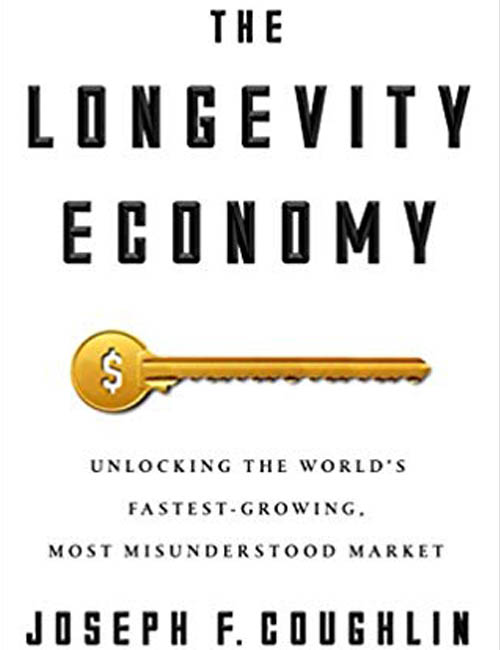Reviewed by Kay Corry Aubrey, kay@usabilityresources.net
User Researcher, Usability Resources Inc., Bedford, MA
Each day in the United States, ten thousand Baby Boomers turn 65. People over 55 currently own over half of the disposable income, and with the US birth rate falling, by 2060 one quarter of the population will be over 65. This aging trend is well established and replicated throughout the developed world. So why do businesses keep
creating products and services geared toward 25- to 40-year-olds?
In The Longevity Economy, Joseph Coughlin presents a comprehensive and engaging look into the roots of how aging has come to be seen as “a problem to be solved” rather than a life stage that we all hopefully reach and get to enjoy as fully capable and contributing humans. According to Coughlin, this unconscious cultural bias stifles the imagination of businesses resulting in bland and clunky products that address only the physical and mental decline that can go with aging, such as senior foods, adult diapers and “Help I’ve fallen and can’t get up” medical devices.
Coughlin is the founder and director of the Massachusetts Institute of Technology AgeLab, whose focus is to show how we can invent a “Life Tomorrow” that makes the most of our extended lifespan. While the AgeLab is part of the School of Engin-eering, it relies on a multi-disciplinary approach to innovation that leverages insights from engineers, architects, and social scientists. They have close partnerships with major automakers, retailers, insurance companies, and other industries and are actively involved in the research and design of technologies that will likely become commonplace, such as self-driving cars. His team focuses on developing technologies that will not only make it easier for older people to live full and independent lives as we get older but also serve consumers of all ages.
The first part of the book focuses on the myths of old age that explain how we arrived at our current beliefs around aging and how these perceptions are out of sync with today’s reality. It wasn’t until the early 19th century that “the aged” were seen as a separate demographic group defined by the prevailing trends in Western medicine that to be old meant running out of “vital energy.” In those days, old meant over 40. As the economy grew, so did the focus on efficiency and the belief that older workers should step aside to let younger people take over because older people were seen as no longer having the stamina, ability, and focus to do their jobs. Social Security institutionalized this last phase of life. When Social Security was created, however, the life expectancy of an average American was 63 versus the 78 years it is today. This situation has created what Coughlin calls “The Longevity Paradox,” where we are living longer but are challenged with what we do with the additional years of life.
Qualitative researchers and anyone involved in product and service development and marketing will be most interested to learn about the AgeLab’s research methods that produce transcendent products, which Coughlin details in the second part of the book. “Radical empathy” is a cornerstone of what has made them successful. The Lab’s approach merges User Experience, qualitative and quantitative methods with big data. The book describes how the AgeLab runs concepts by a resident “Lifestyle Leader” panel which comprises thirty highly educated, wealthy and accomplished participants who are over 85.
In the chapter “The Future is Female,” Coughlin explains how businesses must design products and services to suit a new type of Lead User—a middle-to-later aged woman who has gained a great deal of life experience and insight through being the primary caregiver of her children, parents, in-laws, and often her husband in later years. She lives longer, is more likely to be still working, and is a major influence on purchasing decisions, which in the US alone amounts to between $5 and $15 trillion annually. Older women have a much more focused and realistic understanding of aging and expect businesses to provide products and services that will help them continue to lead independent and fulfilled lives.
The Longevity Economy offers a fascinating and hopeful view of the future of aging as well as a roadmap for businesses and researchers who wish to engage with this burgeoning, gold-plated, but largely ignored demographic.


Be the first to comment